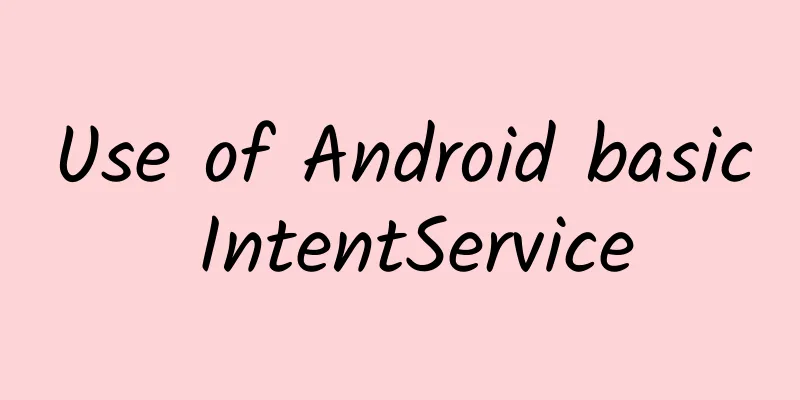|
A brief description of the service 1. Foreground service and IntentService: The foreground service can keep running all the time without being recycled due to insufficient system memory.
Service service test preparation code We use a specific case to illustrate the introduction of the service life cycle of the start and bind methods. The project results are as follows: 1. Do some initialization work in MainActivity.java , as follows: - private final static String TAG = "MyIntentService" ;
- private MyIntentService.MyBinder binder;
-
- private ServiceConnection connection = new ServiceConnection() {
- @Override
- public void onServiceConnected(ComponentName name, IBinder service) {
- binder = (MyIntentService.MyBinder) service;
- binder.sayHello(name.getClassName());
- }
-
- @Override
- public void onServiceDisconnected(ComponentName name) {
- Log.i(TAG, "service disconnect: " + name.getClassName());
- }
- };
-
- @Override
- protected void onCreate(Bundle savedInstanceState) {
- super .onCreate(savedInstanceState);
- setContentView(R.layout.activity_main);
- }
2. Create a simple IntentService service class : MyIntentService - package com.example.linux.intentservicetest;
-
- import android.app.IntentService;
- import android.content.Intent;
- import android.os.Binder;
- import android.os.IBinder;
- import android.util.Log;
-
- public class MyIntentService extends IntentService {
- private final static String TAG = "MyIntentService" ;
- private MyBinder myBinder = new MyBinder();
-
- class MyBinder extends Binder {
- public void sayHello(String name) {
- Log.i(TAG, "say hello method: " + name);
- }
-
- public void sayWorld(String name) {
- Log.i(TAG, "say world method: " + name);
- }
- }
-
- @Override
- public IBinder onBind(Intent intent) {
- return myBinder;
- }
-
- public MyIntentService() {
- super ( "MyIntentService" );
- Log.i(TAG, "myintent service constructor." );
- }
-
- @Override
- public void onCreate() {
- Log.i(TAG, "on create." );
- super .onCreate();
- }
-
- @Override
- protected void onHandleIntent(Intent intent) {
- Log.i(TAG, "handle intent: " + intent.getStringExtra( "username" ) + ", thread: " + Thread.currentThread());
- }
-
- @Override
- public void onDestroy() {
- super .onDestroy();
- Log.i(TAG, "on destroy." );
- }
-
- @Override
- public int onStartCommand(Intent intent, int flags, int startId) {
- Log.i(TAG, "on start command." );
- return super .onStartCommand(intent, flags, startId);
- }
-
- @Override
- public boolean onUnbind(Intent intent) {
-
- String username = intent.getStringExtra( "username" );
- Log.i(TAG, "on unbind: " + super .onUnbind(intent) + ", username: " + username);
- return true ;
- }
-
- @Override
- public void onRebind(Intent intent) {
- Log.i(TAG, "on rebind" );
- super .onRebind(intent);
- }
- }
3. Create a simple front desk service class : FrontService - package com.example.linux.intentservicetest;
-
- import android.app.Notification;
- import android.app.PendingIntent;
- import android.app.Service;
- import android.content.Intent;
- import android.os.IBinder;
- import android.util.Log;
-
- public class FrontService extends Service {
- private final static String TAG = "MyIntentService" ;
- public FrontService() {
- Log.i(TAG, "front service constructor" );
- }
-
- @Override
- public IBinder onBind(Intent intent) {
- return null ;
- }
-
- @Override
- public void onCreate() {
- super .onCreate();
- Notification.Builder builder = new Notification.Builder( this );
- Intent intent = new Intent( this , MainActivity. class );
- PendingIntent pendingIntent = PendingIntent.getActivity( this , 0, intent,
- PendingIntent.FLAG_CANCEL_CURRENT);
-
- builder.setSmallIcon(R.mipmap.ic_launcher).setTicker( "ticker" );
- builder.setWhen(System.currentTimeMillis()).setAutoCancel( true );
- builder.setContentTitle( "content title" ).setContentText( "content text" );
- builder.setContentIntent(pendingIntent);
-
- Notification notify = builder.getNotification();
-
- notify.defaults = Notification.DEFAULT_ALL;
- startForeground(10, notify);
- }
- }
4. Register services and activities in AndroidManifest.xml : - <activity android:name= ".MainActivity" >
- <intent-filter>
- <action android:name= "android.intent.action.MAIN" />
- <category android:name= "android.intent.category.LAUNCHER" />
- </intent-filter>
- </activity>
-
- <service
- android:name= ".MyIntentService"
- android:exported= "false" >
- </service>
- <service
- android:name= ".FrontService"
- android:enabled= "true"
- android:exported= "true" >
- </service>
Use of Intent Service 1. Create methods in MainActivity to start and stop services: -
- public void startService(View view) {
- Intent intent = new Intent();
- intent.putExtra( "username" , "linux" );
- intent.setClass(MainActivity. this , MyIntentService. class );
- startService(intent);
- }
-
-
- public void stopService(View view) {
- Intent intent = new Intent();
- intent.setClass(MainActivity. this , MyIntentService. class );
- stopService(intent);
- }
2. Create a method in MainActivity to bind and unbind services: -
- public void bindService(View view) {
- Intent intent = new Intent();
- intent.setClass(MainActivity. this , MyIntentService. class );
- intent.putExtra( "username" , "linux" );
- boolean isBind = bindService(intent, connection, Context.BIND_AUTO_CREATE);
- Log.i(TAG, "bind service: " + isBind);
- }
-
-
- public void unbindService(View view) {
- Intent intent = new Intent();
- intent.setClass(MainActivity. this , MyIntentService. class );
- unbindService(connection);
- }
3. Operation results : Click start:
- 03-25 08:01:53.460 8389-8389/? I/MyIntentService: myintent service constructor.
- 03-25 08:01:53.460 8389-8389/? I/MyIntentService: on create.
- 03-25 08:01:53.475 8389-8389/? I/MyIntentService: on start command.
- 03-25 08:01:53.477 8389-8727/? I/MyIntentService: handle intent: linux, thread: Thread[IntentService[MyIntentService],5,main]
- 03-25 08:01:53.478 8389-8389/? I/MyIntentService: on destroy.
Click stop: no output Click bind:
- 03-25 08:02:25.421 8389-8389/? I/MyIntentService: bind service: true
- 03-25 08:02:25.422 8389-8389/? I/MyIntentService: myintent service constructor.
- 03-25 08:02:25.422 8389-8389/? I/MyIntentService: on create.
- 03-25 08:02:25.432 8389-8389/? I/MyIntentService: say hello method: com.example.linux.intentservicetest.MyIntentService
Click unbind: - 03-25 08:02:28.486 8389-8389/? I/MyIntentService: on unbind: false , username: linux
- 03-25 08:02:28.490 8389-8389/? I/MyIntentService: on destroy.
Use of front desk services 1. Create a method in MainActivity to start the foreground service: -
- public void frontService(View view) {
- Intent intent = new Intent();
- intent.setClass(MainActivity. this , FrontService. class );
- startService(intent);
- }
2. Operation results : In the notification bar of the mobile phone Analysis of the principle of IntentService 1. intentService is an abstract method that inherits Service : - public abstract class IntentService extends Service
2. Some fields contained in intentService are referenced as follows : - private volatile Looper mServiceLooper;
- private volatile ServiceHandler mServiceHandler;
- private String mName;
- private boolean mRedelivery;
-
- private final class ServiceHandler extends Handler {
- public ServiceHandler(Looper looper) {
- super (looper);
- }
-
- @Override
- public void handleMessage(Message msg) {
- onHandleIntent((Intent)msg.obj);
- stopSelf(msg.arg1);
- }
- }
2. When starting a service, the constructor is executed first, followed by the onCreate method, and then the onStartCommand method. The onStart method is executed in onStartCommand (the execution process is described in Android Basics ----> Service Lifecycle): The onCreate method starts a thread, gets the Looper and initializes a Handler
- @Override
- public void onCreate() {
-
-
-
-
- super .onCreate();
- HandlerThread thread = new HandlerThread( "IntentService[" + mName + "]" );
- thread.start();
-
- mServiceLooper = thread.getLooper();
- mServiceHandler = new ServiceHandler(mServiceLooper);
- }
onStart method, using the above Handler to send information - @Override
- public void onStart(Intent intent, int startId) {
- Message msg = mServiceHandler.obtainMessage();
- msg.arg1 = startId;
- msg.obj = intent;
- mServiceHandler.sendMessage(msg);
- }
onStartCommand method, calls onStart method, sends information - @Override
- public int onStartCommand(Intent intent, int flags, int startId) {
- onStart(intent, startId);
- return mRedelivery ? START_REDELIVER_INTENT : START_NOT_STICKY;
- }
-
***The above Handler gets the information and calls the handleMessage method, which contains the stopSelf(msg.arg1) method to stop the service:
3. Here are two methods of the service class, the source code is android6.0 The onStart method in Service has been deprecated:
-
-
- @Deprecated
- public void onStart(Intent intent, int startId) {
- }
In the onStartCommand method - public int onStartCommand(Intent intent, int flags, int startId) {
- onStart(intent, startId);
- return mStartCompatibility ? START_STICKY_COMPATIBILITY : START_STICKY;
- }
-
| 









